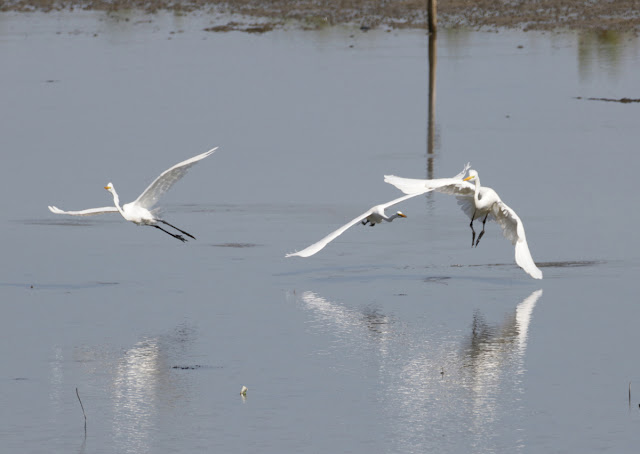Boobies attach themselves to any ship, with all the flying fish zipping out from the bow wake the chance of a relatively easy meal is way to good to pass up. In doing so they inadvertently provide a spectacular and photogenic escort through their oceanic territory. It was noticeable that when, after many miles, the Volcano Is Brown and Red-footed Boobies left us there was a brief period the fish could fly in safety before the more northerly Ogasawara Brown Boobies joined us. This was repeated further north the following day when there was another stretch of booby-free ocean after the Ogasawara escort peeled off and before the Izu Is birds came along side.
Brown Booby is a widespread species throughout the warmer waters of Japan and can even be seen in Kyushu coastal waters in winter... in harbours if you're lucky. Masked and Red-footed, unless storm-blown, require visits to more remote island groups. Red-footed is a common breeder in the Volcano Islands and Masked in the Yaeyama Islands.
Now you could say, 'when you've seen one Brown Booby you've seen them all'. You could; but it turns out you'd be wise not to, as I was to find out. Apart from females being significantly larger than males the sexes look alike, nor is there any readily apparent individual variation. On this trip I was interested in getting some shots of immature Brown Booby partly because I've seen very few and there seems very little variation in appearance compared to the immature Northern Gannets I used to see in the UK, with their gradual progression to adult plumage. Also partly because I remember in my teens the late Richard Richardson chasing me up for notes on an 'immature Gannet' we'd seen a few months earlier, Richard had a nagging doubt that it might have been an immature booby.
In that light it's all the more galling that the potential bird of the trip, a Brewster's Brown Booby
Sula leucogaster brewsteri, was one that got away. It simply wasn't on my radar. According to the notoriously out-of-date OSJ list there's only been one Japanese record, however with a growing number of records in Hawaii, including breeding, this has to be a taxon to look out for in the Volcano Islands. The amazing occurrence of Nazca Boobies in Hawaii would also make any Masked Booby (which I've yet to see in the Volcano Is) worth more than the passing glance I allowed this bird.
I saw it approaching from the rear at about eye level, as boobies so often do, while we were slowly circumnavigating the southern island of the group. It was strikingly white about the forehead and fore-crown and the bill looked more reflective and colourless unlike the usual bright yellow. In fact it actually suggested an approaching Brown Noddy but as it was plainly a booby I lost interest before I'd had time to actually process what I was looking at. At that moment there was so much activity with Red-tailed Tropicbirds, White Terns, Brown Noddies and the potential for who knows what that the ship's daily escort simply wasn't a priority and I didn't even attempt to get any shots of it. It was only later as normalcy returned that the idea of a white-headed Brown Booby caused the cogs to slowly creak into action. The pain of this particular loss may diminish with passing time but at present the opposite seems to be the case.
Anyway... few images of the ones that didn't get away.
 |
| Juvenile Brown Booby |
 |
| An April immature Brown Booby from the Yaeyama Is. I expect with the similar latitude the breeding timing will also be similar and this appearance with moult in the remiges and body fits a 2CY. |
 |
| Juvenile Red-footed Booby |
 |
| The same bird as above, the upperparts look strikingly grey at a distance. |
 |
| Red-footed Booby in early November. So how old is this one? The potential for a very protracted breeding season could mean this is also a 1CY but perhaps 2CY seems more likely. If so then Red-footed must show a greater plumage variation between Juvenile and adult compared to Brown. |
 |
| Flight feather moult apparent here; I can only see nine primaries and the outermost is half grown. This must make it a 2CY. |
 |
| The same bird as above; upperparts for comparison with next bird. |
 |
| Compared to the previous bird this has slightly more white on the upperparts and white-spotted outer wing coverts. There doesn't seem a vast difference between this and the previous bird but this is a July bird, a full eight months later... or four months earlier. |
 |
| Same bird as above. |
 |
| A far more advanced immature this month, just north of Ogasawara. |
 |
| The same bird as above. |
 |
| July immature with stepped wing moult, much brown in tail but breeding adult facial pattern. |
 |
| Same bird as above. Two moult loci in both primaries and secondaries. |
 |
| Adult Brown Booby |
 |
| Male Brown Booby |
 |
| Female Brown Booby |
 |
| Adult Red-footed Booby September, facial area without intense breeding colouration. |
 |
| July adult red-footed Booby with more intense facial colouration. |
 |
| April Masked Booby |
Even though I was really hoping to find rare seabirds on the trip, it was really difficult not to be distracted by the boobies putting on a great show alongside the ship. Particularly where the less often seen Red-footed was concerned.
The plunge...
The pursuit...

















































